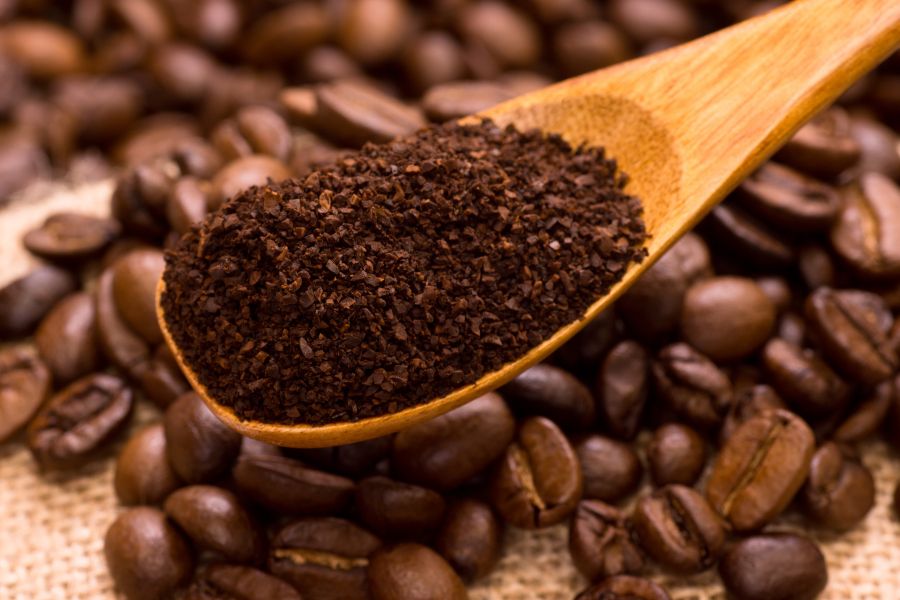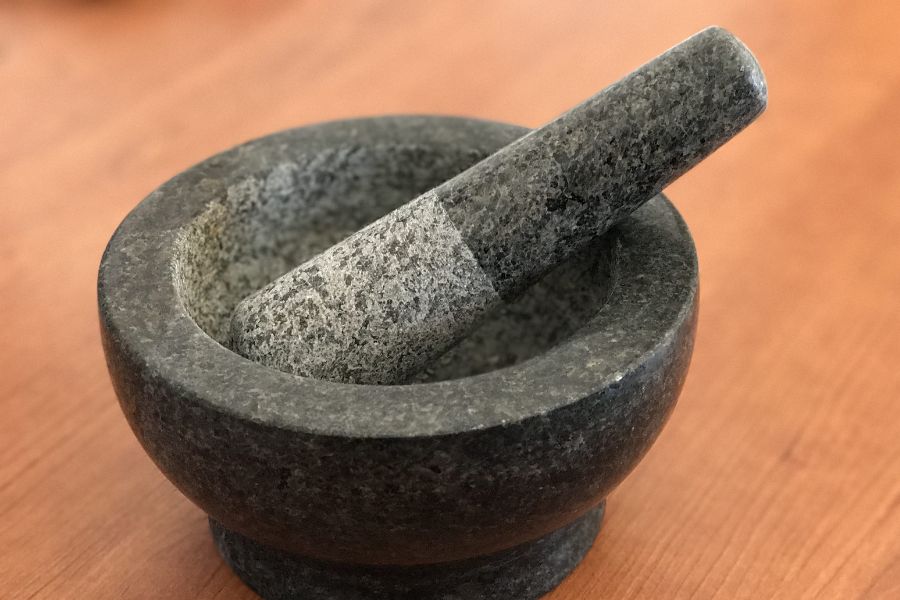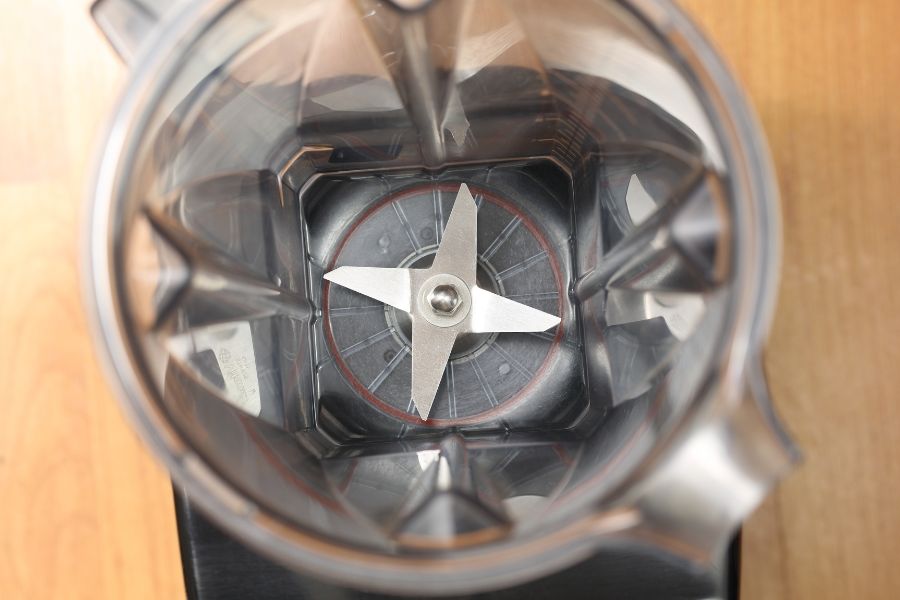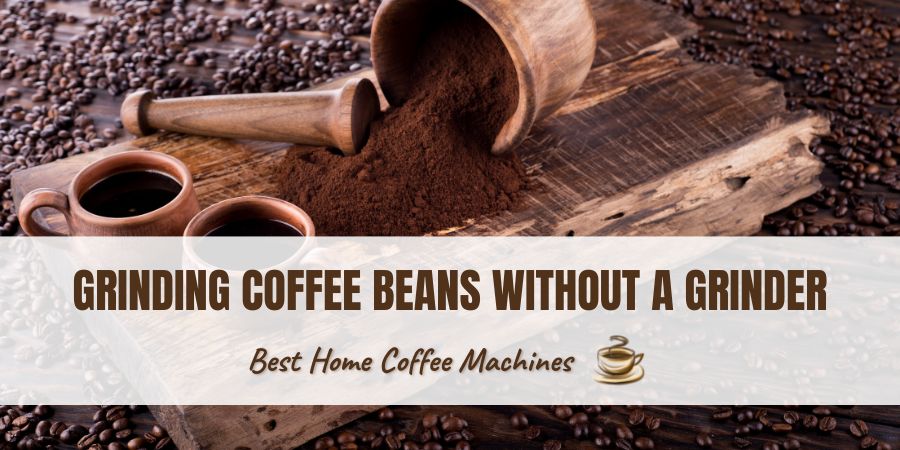How To Grind Coffee Beans Without a Grinder
Ever been taunted by your coffee maker and whole coffee beans, sitting there on the bench ready to be used, but you don’t have a coffee grinder? There is a solution. Knowing how to grind coffee beans at home (without a grinder) can mean the difference between staring longingly at those coffee beans and enjoying that rich cup of java.
Most bean lovers understand the importance of freshly ground coffee. Since coffee starts losing its flavor and aroma quickly after grinding, grinding beans right before brewing is a way to lock those flavors in.
Fortunately, you have other options if you don’t have an actual grinder for coffee beans.
Simple household tools like a hammer, rolling pin, or food processor can be used to grind coffee. There’s no need to contemplate going without your morning cup of joe. Read on for the critical intel on grinding coffee beans without a grinder.
Coming up in this article:
Benefits of Grinding Your Own Beans
You’ve probably heard coffee aficionados stress the importance of freshly ground coffee beans for brewing great java. But why?
As soon as coffee beans are ground, they’re exposed to air and moisture in the environment. Natural oils from the beans also escape. This accelerates the loss of coffee’s wonderful aroma and flavor.
In fact, the longer you wait between grinding and brewing, the more that disappears. By grinding immediately before brewing, you preserve more of that flavor and aroma, and your java tastes better.
When grinding your own coffee beans, you’re fully in control of how much you grind and the grind level. If you only need a little ground coffee, that’s easy to accommodate. You’re also not restricted to just one grind level, as you would be with a bag of pre-ground coffee. You can grind coarsely for French press java one morning and then grind finely for espresso the next.

Alternative Methods for Grinding Beans
If you’re jonesing for that cup of joe, but all you have are whole coffee beans and no grinder, what’s a person to do?
We have some alternative and unconventional methods that can be used to grind coffee beans without a grinder.
Blender
An electric blender grinds beans quickly as it operates just like a blade grinder for coffee beans. Any blender will do a decent job but expect inconsistent grind sizes. However, if you want a coarse grind, this can get the job done and quickly.
Heat is created when a blender is operating, and that heat can be transferred to the beans. This may result in a beverage that tastes bitter. You should also carefully clean your blender afterward, or anything you put in the blender later may smell or taste like coffee.
Food Processor
Like the blender, a food processor is similar to a blade grinder. As with a blender, grinds may be inconsistent, and heat generated may damage the coffee beans. Most food processors can produce an adequate coarse grind, though.
Again, you should thoroughly clean your food processor after using it to grind coffee. Unless you like your chopped veggies to taste like java, of course!
Rolling Pin
A rolling pin is more labor-intensive than the previous methods as it’s powered by your arms and not electricity. It also takes considerably longer than electric methods. However, it’s possible to get a coarse, medium, or even fine grind with a rolling pin. Granted, not everyone has one on hand, but if you don’t, you probably have at least one of the other tools.
Mortar and Pestle
The mortar and pestle have been used for centuries to grind coffee, spices, and other food items. It’s definitely labor-intensive as it requires some arm strength. You’ll also have to be cognizant of the fact that there’s no lid — you don’t want coffee beans to go flying!
It’s wise to use a smaller amount of coffee beans than with other methods so you can keep everything within the bowl. However, you can get a very consistent coarse, medium, or even extra-fine grind.
Pro tip: Hold the pestle with your stronger hand and use your other hand for the mortar bowl. This will make it easier to crush the beans.

Meat Tenderizer or Hammer
You may already have a meat tenderizing mallet in your kitchen. If not, an ordinary hammer will also do the trick. However, don’t use it as you would when hammering a nail. You’re not smashing beans, you’re just applying pressure to crush them.
Use caution with this method as you can damage countertops if you apply too much pressure. A large cutting board offers the best protection. You can pretty easily achieve a coarse grind with a hammer, although the grinds may not be consistently sized.
Knife
No, you won’t be slicing coffee beans. Instead, use the flat of a knife blade to crush beans into a medium or medium-fine grind level. This method offers more control over consistency as only a few beans are crushed at a time.
It goes without saying that you should use caution with this method, though. Knives can be sharp and dangerous, and you want to make java, not visit your local hospital’s emergency room!
What You’ll Need for These Methods
Before you can start using these methods of grinding coffee beans, you’ll need to make sure all the necessary items are available.
Blender
- Electric blender with a lid
- Measuring cup
- ¼ to ½ cup whole coffee beans
Food Processor
- Food processor with lid
- Measuring cup
- ¼ to ½ cup whole coffee beans
Rolling Pin
- Rolling pin
- Sealable plastic bag
- Large cutting board
- Your preferred amount of whole coffee beans
Mortar and Pestle
- Mortar and pestle
- Whole coffee beans (no more than ¼ to ½ the capacity of your mortar)
Meat Tenderizer or Hammer
- Mallet for meat tenderizing or hammer
- Sealable plastic bag
- Large cutting board
- Your preferred amount of whole coffee beans
Knife
- Butcher’s knife or chef’s knife
- Large cutting board
- Whole coffee beans

How to Grind Beans with No Grinder
Blender
- Measure ¼ to ½ cup of whole coffee beans and add to the blender.
- Use the grinder setting, medium-high setting, or pulse setting.
- Do short bursts, using the pulse feature a maximum of 5 to 6 times.
- Total blending time should be less than 30 seconds.
- You may need to tilt the blender jar in between bursts to level out those grinds.
Food Processor
- Add ¼ to ½ cup of whole coffee beans and make sure the lid is secured.
- Do short bursts of chopping/grinding for a maximum of 20 to 30 seconds.
- Your container may need to be tilted slightly to evenly distribute the ground coffee.
Rolling Pin
- Put coffee beans inside the plastic bag, then seal it after forcing all the air out.
- Lay the bag of beans flat on a durable counter surface or large cutting board.
- Crush the beans with your rolling pin, using it like you would a hammer — but not nearly as hard!
- Once all beans are broken, firmly roll over them repeatedly.
- Push beans back to the center if they slide and repeat the rolling process as many times as necessary.
Mortar and Pestle
Keep in mind that there’s no lid with a mortar and pestle, so if you put too many beans in a mortar bowl, they may fly out. For this reason, only use enough beans to fill no more than half the bowl.
- Use your stronger hand to hold the pestle and hold the mortar bowl with the other hand.
- Place the whole coffee beans in the mortar.
- Push down on the pestle with a twisting motion to crush the beans.
- Once your initial crushing is complete, use a circular motion with the pestle to reach your preferred grind level.
Meat Tenderizer or Hammer
- Put the beans inside your plastic bag. Then force all remaining air out of the bag and seal it.
- Place the bag of beans on a sturdy counter or a large cutting board.
- Firmly press down on the hammer to crush the beans.
- As you crush coffee beans, move them to the side, so their sizes will be more consistent.
- Repeat this process as necessary until you’re satisfied with the grind level.
Knife
- Use caution with this one as knives can cause injury.
- Place a small amount (about 2 tablespoons) of coffee beans on a cutting board.
- Using the flat of a blade — not the sharp edge! — place your palm down flat on the blade. Firmly press down to crack the coffee beans.
- Continue to press down, but pull the knife toward you to flatten those beans more.
- Repeat this process as many times as necessary to get your preferred grind level.
- Set crushed beans aside and repeat with additional beans.

Tips and Pointers
The first time you try a new technique may be a little rocky, and grinding coffee beans without an actual coffee grinder is no different. We have some suggestions that might make the process easier.
If you’re grinding by hand, do a few at a time – Using small amounts means that the whole process takes longer but it’s the best way to get consistent grind sizes.
When done grinding, wash your tools – If you don’t wash them immediately, the coffee remnants and aroma will affect whatever food is used next. This is particularly true with blenders or food processors. But it’s also a good idea to thoroughly wash your rolling pin, knife, hammer, or mallet.
Don’t have unrealistic expectations – Grinding without a coffee grinder will not produce ground coffee that’s as good as what a real grinder produces. It’s best not to go into this process expecting that perfect espresso grind. French press java is your best bet if you’re grinding coffee beans with anything other than a coffee grinder. This method is much more forgiving, and you don’t have to work quite as hard to reach a proper grind.
Recapping
Whether your coffee grinder just conked out, or it’s simply nowhere to be found, you don’t have to face your morning without java. Grinding coffee without a grinder is a useful skill, one you can do manually or with other kitchen appliances. Learning how to make coffee from beans without a machine will come in handy at some point.
If you’re grinding coffee beans by hand, expect it to take some strength and time. Depending on which method you choose, you can grind coarsely or finely. However, don’t bank on this ground coffee being the same as what an actual coffee bean grinder can make.
It’s going to be difficult to achieve consistently even grinds, but you’re more likely to get that by using a very small amount of coffee beans at one time. So pull out that rolling pin or food processor and get busy grinding!
How to Grind Coffee Beans Without a Grinder FAQs
Can You Brew Coffee Beans Without Grinding Them?
Technically, yes, it’s possible to brew coffee beans without grinding them, but the process takes a lot longer than with ground coffee. You can simmer whole beans in water for at least an hour and then strain that liquid for coffee. However, it’s much faster to grind them with kitchen tools or gadgets like a food processor.
How Can I Grind Coffee Beans Without a Grinder?
If you don’t have a coffee grinder, there are several ways to grind coffee beans with tools in your own kitchen. You can grind beans with a hammer or meat tenderizer, blender, food processor, rolling pin, or the flat of a knife blade.
Do I Really Need a Coffee Grinder?
Yes, we suggest a coffee grinder for anyone who regularly brews java at home. The best coffee comes from freshly ground coffee beans, and you will maximize that freshness by grinding beans right before brewing.
Is It Better to Manually Grind Coffee?
It’s more time-consuming to manually grind coffee beans, and it’s certainly easier to use a real coffee grinder. However, in the event that you don’t have a bean grinder, there are ways you can manually grind beans.
Will Coffee Beans Ruin a Blender?
No, coffee beans will not ruin a blender, but you should carefully wash all blender parts immediately after using them to grind coffee. Otherwise, whatever goes into that blender next may pick up some of the java taste and smell.
Can I Grind my Coffee Beans the Night Before?
Yes, you can grind your coffee beans the night before you’ll be using them, but it’s best not to. The aroma and flavor of coffee starts to dissipate almost immediately after beans are ground. You won’t get the full amount of flavors in your beverage if your beans are ground the night before.





